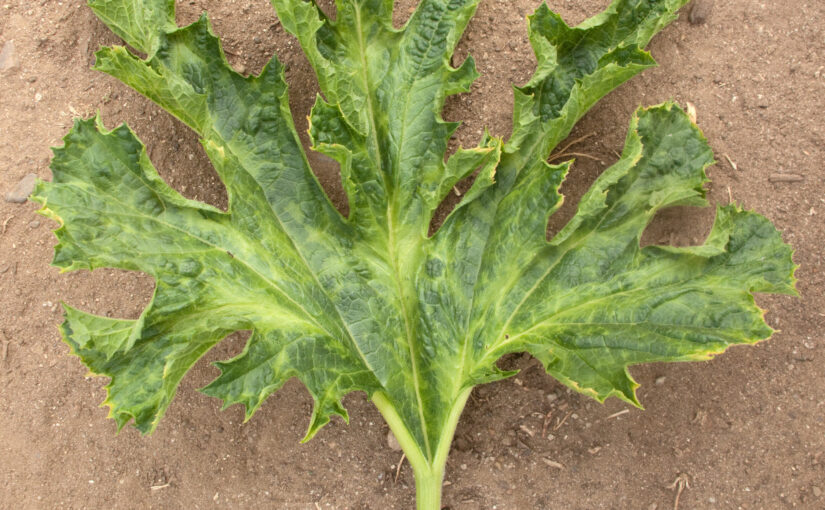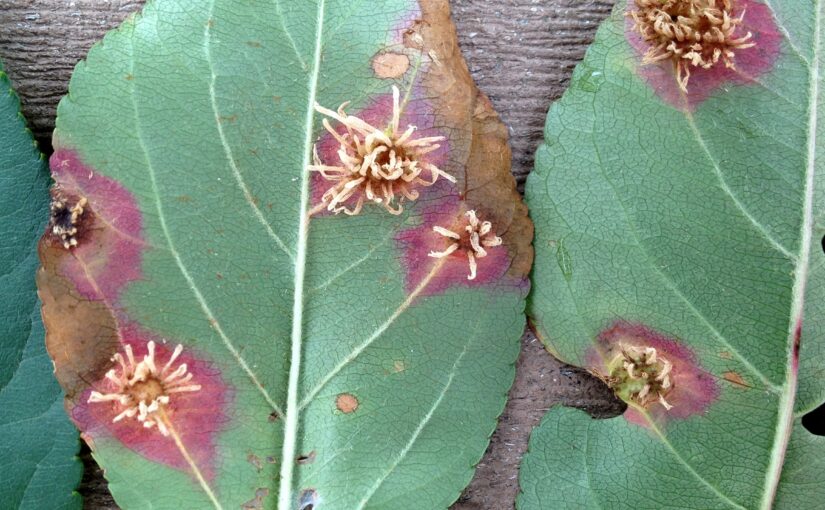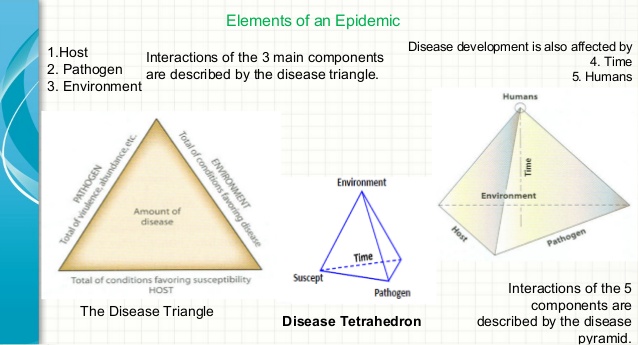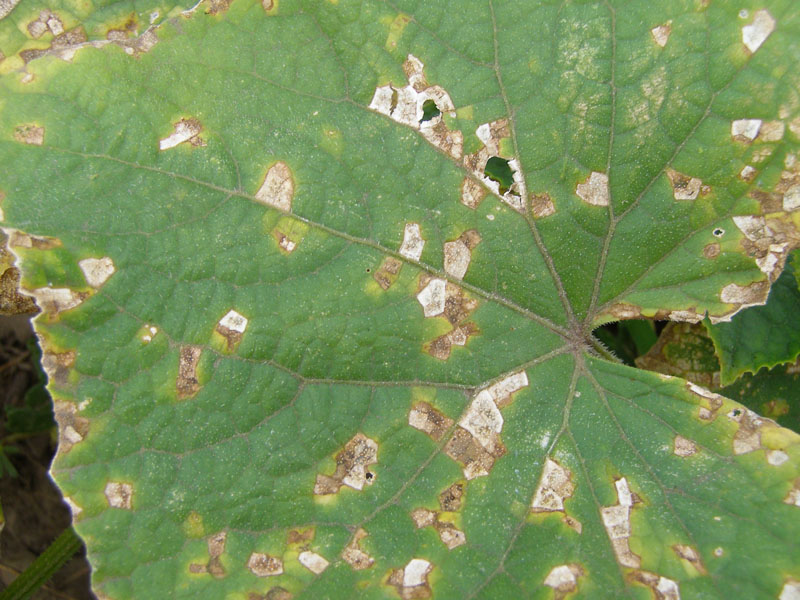Previously in this series I started with some plant disease basics and then covered some common fungal diseases and then bacterial diseases. Now let’s turn our attention to viruses. Just like with fungi and bacteria before, in this installment I’m going to talk about some of the most common viral plant diseases with some suggestions for treatment and prevention. This by no means will be an exhaustive list of diseases (there are so many!), but I hope to cover some of the most common ones that trouble gardeners.
Unlike fungi and bacteria and just like human viruses like the common cold, there typically aren’t treatments that you can use to “cure” or treat a viral infection. Therefore prevention is the only way to limit viral disease spread in plants. Also unlike fungi and bacteria, viruses are not living organisms. They don’t have cellular “machinery” and are typically a snippet of genetic material (DNA or RNA) encased in a protein coat or similar structure. Since they aren’t living, they don’t reproduce outside of a host organism and don’t typically have the ability to spread themselves around the environment, instead relying on hosts to carry them. For plant viral diseases this usually involves manual movement on humans, tools, or possibly animals or inside of a secondary host organism like an insect’s digestive tract. Aphids are a common vector, as they consume and secrete infected sap. Viruses can often spread through infected seed or vegetative propagules like seed potatoes or cuttings. And since they aren’t living entities and are microscopic there are no signs (visible presence of causal agent) of disease, only symptoms.
Mosaic Viruses
I’m lumping mosaic viruses together because there are lots and lots of them, each affecting a different range of host plants but with similar symptoms. Many viruses affect a specific species or genus of plants while others have a broad host range. Common symptoms include: yellowing, mottling, mosaic patterns on leaves, curling, stunted growth, reduced fruit quality and size, and necrosis.
Tobacco mosaic virus (TMV) is the most persistent and infectious virus and has a very wide host range, including tobacco and other members of the Solanaceae family like tomatoes, potatoes, and peppers, other vegetables, and ornamental plants. The host range is estimated to be up to 350 species.

TMV is spread through sap and infected seeds. Virus transmission through sap can be a result of physical contact (brushing against plants when moving through a field/garden), dirty tools, aphid feeding, or even from tobacco use. TMV is so pervasive and persistent that many nursery and greenhouse businesses have strict tobacco policies for employees and for employees who do use tobacco there is usually a hand sanitation requirement.

Other mosaic viruses include Tomato Mosaic Virus (ToMV), Cucumber Mosaic Virus (CMV), Zucchini Yellow Mosaic Virus (ZYMV), Cauliflower Mosaic Virus (CaMV), Squash Mosaic Virus (SqMV), Bean Common Mosaic Virus (BCMV), and Rose Mosaic Virus (RMV).

Tomato Yellow Leaf Curl Virus (TYLCV)
- Common symptoms: Yellowing and curling of leaves, stunted growth
- Host Plants: Tomatoes, Peppers
- Insect Vectors: Whitefly
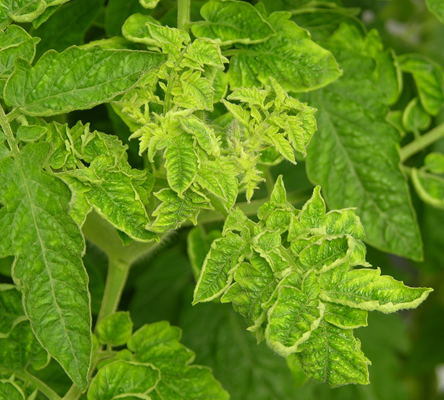
Tomato Ringspot Virus (ToRSV)
- Common symptoms: yellow rings on leaves, mottling, distortion, mosaic, rings on fruits, necrosis
- Host Plants: Tomatoes, other Solanaceous crops, wide range of others
- Vector: Nematodes
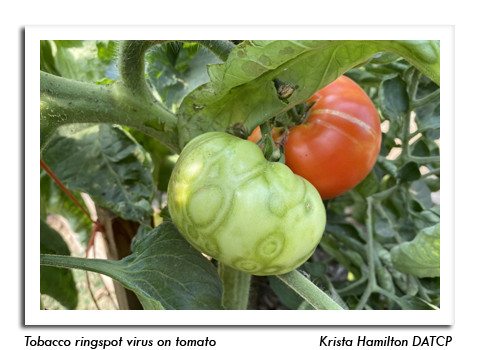
Potato Virus Y (PVY)
- Common symptoms: Leaf discoloration, mosaic patterns, tuber deformation
- Host Plants: Potatoes, Tomatoes, Peppers
- Insect vector: aphids

Hosta Virus X (HVX)
- Common Symptoms: irregular yellow or light green streaks, mottling, leaf distortion, feathering pattern (looks like colors painted on by brush), stunting, and reduced vigor
- Host Plants: Hosta
- Insect Vectors: None/unknown
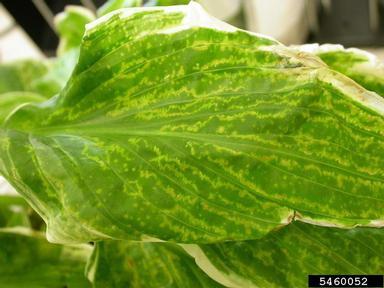
Rose Rosette Disease (RRD)
- Common symptoms: Rapid growth, witches brooming, excessive red coloration (in terminal bracts), deformed leaves, excessive thorns
- Host Plants: Roses
- Insect Vectors: Eriophyid mites

Plum Pox Virus (PPV)
- Symptoms: Leaf distortion, fruit deformities
- Host Plants: Plum, peach, apricot
- Insect Vectors: Aphids
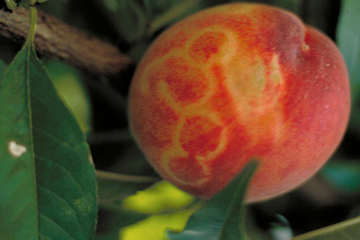
Control and Prevention
Unfortunately, since there is no treatment for viruses and plants don’t have immune responses that eliminate them like humans and animals do, the only “control” for viruses in the garden is by removal of infected plants. There is no way to “cure” an infected plant, but removal from the landscape or garden can reduce the viral load available to vectors in the garden and can help slow or eliminate the spread to other plants. Since symptoms may not appear right away, it is possible that viruses can spread to multiple plants before detection.
Since viral infection typically means a death-sentence for the plant, prevention through Integrated Pest Management is of utmost importance. Here are some common and effective IMP practices that can help reduce the spread of viruses in the garden.
- Purchase certified disease-free seeds or plant cuttings. Unfortunately, viruses can spread easily through untested seeds and cuttings so take caution in sharing at places like plant and seed swaps.
- Practice good sanitation: remove and destroy infected leaves and plants ASAP
- Clean tools regularly: viruses spread through sap transfer, so cleaning and disinfecting tools is a must. Sometimes in high-value or susceptible plants, disinfection should be done between using tools on individual plants, especially pruners. Use a dilute 10% bleach solution, rubbing alcohol, or horticultural sanitizer for best results.
- Quarantine new plants: If a plant appears suspicious, keep it potted in an out of the way place until you can determine possible infection. This is especially important for plants from discount retailers, plant swaps, etc but can hold true for plants from any source.
- Purchase disease-resistant cultivars when possible.
- Control vector insects, especially aphids.
- Wash hands before gardening, ESPECIALLY if you are a tobacco user.
- Do not use tobacco products while gardening.
Wrapping it up
There are lots of bacterial diseases that can damage or kill plants in our gardens or landscapes. Prevention is key, as treatments only help slow the spread of disease. In the next (and final) installment, we’ll talk about diseases that are caused by things that aren’t fungi, bacteria, or viruses.
